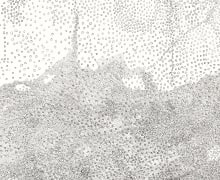

Jacob El Hanani’s title, Recent Works on Canvas, is self-effacingly innocuous. The show itself is equally modest, only 12 ink-on-gessoed canvas works produced between 2017 and 2021. But the effect of the ensemble is overwhelming: intimacy on a grand scale. Like certain buildings, the Petit Trianon or the Amalienburg hunting lodge, which dazzle both in their totality and in their smallest details, this show, through a combination of large scale and virtually microscopic images, leaves us transfixed. What we see from a distance is one thing; what we see peering through a magnifying glass is something completely different. And El Hanani accomplishes all this with ink, brushes, and the infinite patience of the calligrapher.
Writing has been compared to plowing a field; the pen has been compared to a phallus, the ink to semen. Jacob El Hanani sidesteps these all-too-masculine images of fecundation and domination to focus on the act of inscription, the moment when the writing instrument, under the tutelage of the inspired mind, transforms letters, themselves fraught with esoteric meanings according to the Kabbalists, into words, words into sentences, sentences into books. He is a writer, but his discontinuous narrative is a meditation on the act of writing as an affirmation of identity rather than the writing of a particular subject.
Take his Circle Maker (Honi Ham’eaggel) (2019–20). Honi was a first-century scholar who came to the aid of his people during a drought. He drew a circle in the dust and informed God he would not move until God made rain. A controversial tale, but the part that relates to El Hanani is the tracing of the circle. Honi within the circle, a circumference, is a man who acknowledges his human limitations by establishing boundaries and pays homage to the deity who knows no limits and is all-powerful. El Hanani takes the idea of circle-drawing as an expression of limits to create a portrait of humanity, all of us like Honi in his circle. Seen at a distance, the canvas looks like a swarm of insects constantly changing shape. Seen at close range, the work is composed of thousands of circles drawn freehand, so no one circle is identical to any other.
El Hanani constantly compares human creation—Honi and his circle—to divine creation. Another canvas comes to the point: Without Form and Void (Tohu Wa-bohu) (2019), translated in the King James Bible, Genesis 1, as “without form and void.” After these words, the Spirit of God moves over the waters and creates light, His first differentiation of matter. Deus Artifex, God the Artist, creates the world. El Hanani, like Honi, can only create simulacra after hovering over his personal void, the blank canvas covered with gesso. In this work, Honi’s circles are replaced by myriad short lines, some superimposed on others. Shapes, vaguely circular, appear in the morass, emerging like Michelangelo’s unfinished sculptures of slaves or prisoners. For El Hanani, the white surface is a challenging emptiness on which he must inscribe something—words, letters arranged into pictorial shapes—that ultimately becomes a metaphorical self-portrait.
Ivrit (2020), a small 10 × 10 piece, opens El Hanani’s way into landscape. The picture, whose title refers to an ancient form of Hebrew, divides into three discrete zones: in the upper level, the space between lines of text is wide; in the intermediate, space is progressively constricted; in the lowest level, the lines are packed tightly. The artist creates his version of the three spheres of the traditional universe: heaven, earth, and the underworld. This is a static vision of a dynamic nature, the realms together yet separate. Circle and Linescape (2018) plays with the same tripartite division but disrupts the harmony. Now there is interplay among the three realms carried out by the same tiny circles El Hanani uses in Circle Maker: the human presence in the natural order that transforms divine creation into the human universe. El Hanani’s pun “linescape,” his own substitution for landscape, explains his own transformation of the blank canvas into a microcosm.
Those familiar with El Hanani’s work will find here subjects they know: The Hebrew Barbed Wire (2018) transforms the letters of the Hebrew alphabet into the barbed wire of imprisonment and oppression. This allusion to sustaining, collective memory is an important cultural aspect of El Hanani’s art: he is grounded in a linguistic past he uses not with pious nostalgia but with an eye toward creating new worlds.